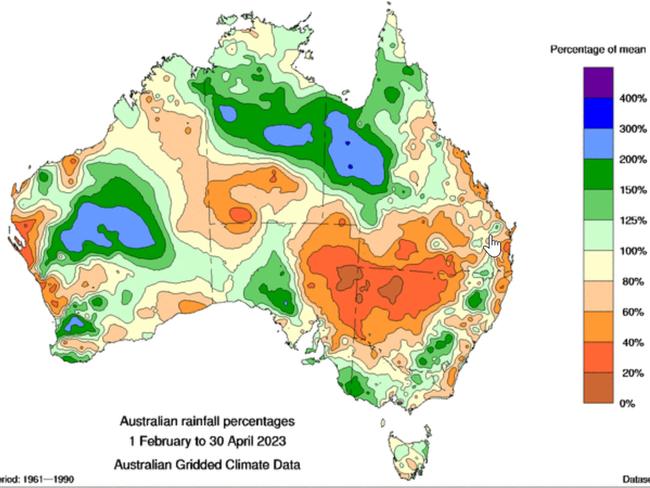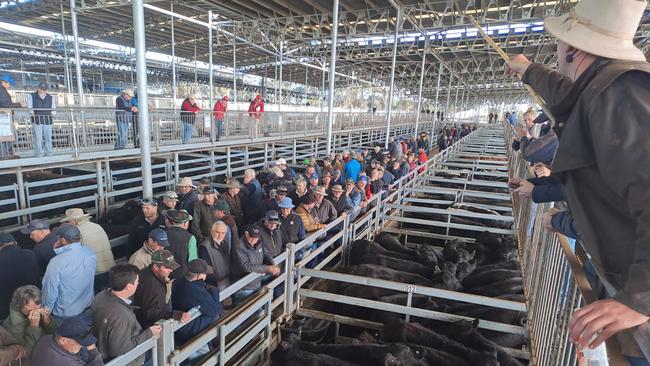Cattle prices: Dry weather to play crucial role in cattle market
Dry conditions across the eastern states of Australia are ripping confidence out of the cattle market. Full analysis here.
Regional pricing for livestock is now starting to come into play as a big brown dry patch sits over the centre of the eastern states.
Cow markets have started to reflect rainfall patterns, and price differences for young steers were evident at major Victorian store sales last week based around location and seasonal confidence.
The map on this page shows how areas across the country are becoming desperate for moisture, regions that are okay but looking for follow-up rain, and parts that are basking in a near-perfect autumn.
To focus on the positive first, there were stronger than expected prices for steers at the big Mortlake store sale last week.
All the major lines of young black steers at Mortlake averaged over 400c/kg liveweight, with the National Livestock Reporting Service quoting an average of 459c/kg or $1144 for calves in the 200-280kg weight range.

Yet a day later, at the monthly Ballarat store sale, the market didn’t post any averages over 400c/kg. It recorded an average of 388c/kg or $982 for steers in the 200-280kg size range, according to data from AgriNous.
Now admittedly, the Mortlake sale was a bigger, better-quality yarding with several feature lines of Angus calves. But a difference of more than 50c/kg is too great to be simply quality.
And that is where the season comes into play. As the map shows, there is a region stretching from around Mortlake, down to Warrnambool and across to southeast South Australia that has received above average rainfall in the past three months (February to end of April).
The Mortlake sale was like its own little trading bubble last week, with virtually all the young steers selling into the area coloured ‘dark green’ by the BOM map, which illustrates how different regions across Australia have faired for rainfall this autumn. Dark green on the map represents 125 per cent to 150 per cent of the average rainfall for the past three months.
Parts of Gippsland and the southwest are okay with about average rainfall, but once above central Victoria, it quickly deteriorates.

The mass of ‘orange’ and ‘brown’ colouring – representing zero to less than 60 per cent of average rainfall for the past three months – is the big problem the industry is facing.
Covering much of central and western NSW and stretching into South Australia and the Northern Territory and up into southern Queensland, it is already impacting pricing, particularly for cull cows, the first category to be sold when the season starts to bite.
All the major saleyards in northern NSW and Queensland have posted price averages below 200c/kg liveweight for cows in the past seven days. These include: Dubbo at 193c/kg for heavy processing cows; Tamworth at 190c/kg; Emerald in Queensland at 195c/kg, and the list, based on NLRS data, continues.
In contrast, Victorian cow prices have been tracking around 230c to 235c/kg to be at a decent premium to the north; 30c/kg on a 550kg cow represents $165.
But the more numbers spill out of the north, the more pressure mounts on southern beef markets. And export buyers have told The Weekly Times they are starting to source more cow numbers from the north as the price deteriorates, and transporting them south becomes a viable option.
Earlier this week on the NSW/Victorian border at Moama, there were several livestock trailers parked that had come out of Quilpie in Queensland – road trains being unable to go past this point into Victoria.

The stressed season is just one of the ‘layers’ of problems affecting livestock markets, others broadly being economic trading conditions and the inability of processors to ramp up production to meet the bigger sell-off of stock due to staffing issues.
But the season, and the lack of rain amid predictions of a dry winter and spring, is starting to exert a lot of influence on livestock markets.
And there are troubling signs in that rainfall map for the sheep and lamb industry.
All those ‘brown’ and ‘orange’ rainfall deficit areas are key sheep breeding regions, home to millions of ewes. If those areas remain dry and end up with lots of little store lambs to sell, against a backdrop of lamb traders coming off two miserable years with thin profit margins, the industry will come under immense pressure.




